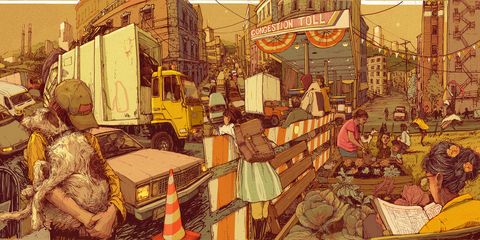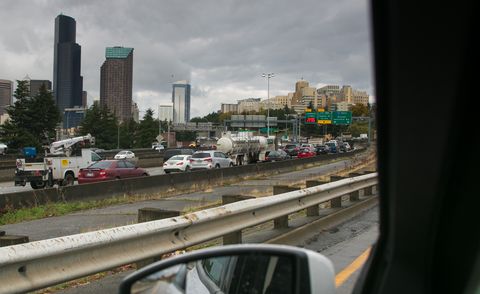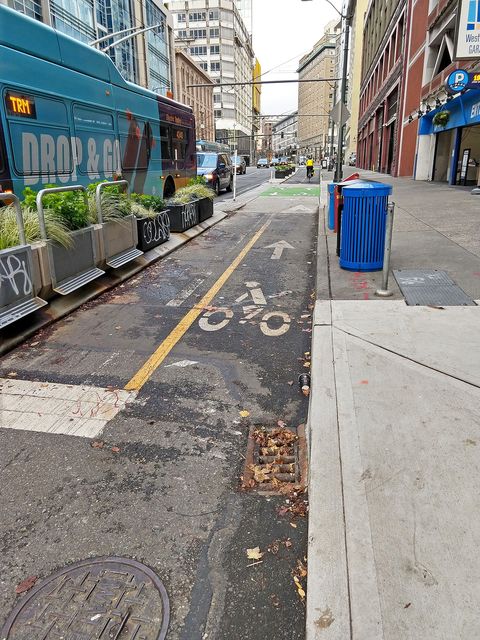I hope St. Augustine institutes whatever legal, constitutional mobility limitations on eighteen wheelers and cut-through traffic that can yield fewer cars and greater happiness for residents, businesses and tourists.
Full disclosure: I am one of the "carless." Never had a driver's license.
Do Sabatini's views seem just a tad overwrought, starting with the histrionic headline (WAR on cars)?
He is right -- cities are trying to solve car-related problems, to wit, congestion.
His last paragraph is accurate -- by limiting cut-through traffic -- perhaps 1/4 of all cars crossing our historic Bridge of Lions -- we can make driving more pleasant for the rest of us.
From Car and Driver:
The War on Cars Is Real, and It's Being Led by Cities
Congestion pricing is just one way cities are actively engaged in reducing the number of cars and the amount of driving.
When they come for our cars," imagined the founding fathers of this magazine, "Big Government will be behind it." This stood to reason, as that was the case with safety mandates, emissions regulations, and the double-nickel era, the policy triumvirate that so riled the libertarian spirit of this institution in years past.
Short of an outright ban, the feds, aided and abetted by the bureaucracies of certain states, would most certainly continue their overreach, eventually all but proscribing the car via requirements too onerous to meet. Uncle Sam's safety nannies, fuel-economy standards, and untenable restrictions on the very act of driving itself would make new cars so dull, slow, and expensive that we would welcome riding the bus. Or so we thought.
This is not how the war on cars is playing out. City governments are the ones taking the lead in creating policies to curtail automobile use in response to congestion and pollution. There are taxes, restrictions, and prohibitions, of course, yet other policies on road design, speed limits, and parking are being devised to entice city dwellers to opt out of car ownership all on their own. At least that is the hope.
Driving up Interstate 5 through Washington State, the traffic starts to build by the time you get to the capital city of Olympia. There are still 65 miles to go until Seattle, and the car crunch of Puget Sound only intensifies as you travel farther north. By Tacoma, it is crawling along, bumper to bumper much of the time. If it were not for the stands of conifers and other greenery along the roadside, it would feel like Los Angeles.
Of course, L.A. has the worst traffic in the world, according to the INRIX 2017 Global Traffic Scorecard; Seattle ranks ninth in the U.S. But in nearby Everett, a bedroom community 25 miles north of downtown, commuters face the highest peak-congestion rate in the country. And traffic is getting worse: In its most recent assessment of the state's highway system, the Washington State Department of Transportation said that congestion in the area rose 22 percent between 2014 and 2016. When it comes to making Seattleites edgy, traffic is more effective than a venti Starbucks. And it makes them motivated to tackle the problem.
In growing cities around the globe, it is a familiar one: too many cars. According to the Seattle Times, among big cities, Seattle has the most cars per capita in the U.S. Traffic jams are just part of the dilemma. Passenger vehicles account for half of Seattle's greenhouse-gas emissions, which the city has pledged to reduce in accordance with the Paris Climate Agreement. To meet its 2030 target, Seattle needs to cut transportation emissions by 82 percent, vehicle miles by 20, and emissions per mile by 75, all from 2008 levels. So Seattle is trying to alleviate its overabundance of cars through public-policy changes.
"All transportation planning is social engineering," says Mark Hallenbeck, the director of the Washington State Transportation Center at the University of Washington. "We've spent 100 years making it easy to drive. We've spent 100 years making it really hard to take a bus. So people drive, because it makes sense."
That may change in Seattle, which could become the first U.S. city to adopt a congestion tolling system, similar to those in London and Stockholm. Seattle mayor Jenny Durkan has said she wants to have a plan in place by 2021. In September 2018, Seattle was awarded a $2.5 million grant from former New York City mayor Michael R. Bloomberg's American Cities Climate Challenge, money that will be spent, in part, to study and implement such a plan.
One researcher at the RAND Corporation think tank describes congestion charges working "just like a tap," allowing cities to cut traffic immediately and permanently. When London's flat-rate tax for driving into the city center went into effect in 2003, traffic levels fell by some 20 percent, a result mirrored in Stockholm three years later. In 2017, London took the concept even further and began levying a "toxicity" toll on vehicles that do not meet certain emissions standards entering the congestion zone during the business day. In April, it will expand the charge to cover more vehicles and extend enforcement to 24 hours a day, 365 days a year.
Restrictions on driving in big cities are not new—Mexico City has used rolling driving bans since 1989—but they are becoming more common. Paris had enacted temporary bans to combat air pollution before launching a new system in 2017 that bars older vehicles from the city center during the business day and makes all drivers buy and display a corresponding emissions sticker. Hamburg, Germany, banned some diesels in 2018; similar bans are forthcoming in Berlin, Frankfurt, and Stuttgart. Other European capitals that have either enacted or proposed some sort of car ban include Brussels, Madrid, Oslo, and Rome. Last summer, New York City banished cars from Central Park.
Fees and restrictions are just the blunt end of the stick. Cities are also dangling carrots to reduce the concentration of cars on their roads, acknowledging that commuters will only be willing to give up their cars if alternatives become more attractive.
"Making other options appealing often means you have to take away something from cars," says Hallenbeck. "Realistically, in a dense urban environment, cars take up too much space. Land is valuable."
In Seattle, hundreds of street-parking spaces have been removed to make room for buses and streetcars—helping mass transit move quicker—and to create protected bike lanes, making commuting on two wheels less harrowing. (The city has even followed San Francisco's lead in establishing a "parklet" program to allow street-parking spaces to be converted to public spaces, many resembling outdoor cafés.) The city began lowering speed limits in 2016 as part of its Vision Zero campaign, including adopting a 20-mph residential limit and dropping the downtown speed limit from 30 mph to 25. The Vision Zero Network, a nonprofit effort to eliminate traffic fatalities, now counts 34 U.S. cities among its ranks, promoting measures to make public-transit use, bicycling, and walking safer. To that end, within the past five years, other cities such as Boston, New York, and Portland, Oregon, have lowered their speed limits as well.
Seattle is also trying to incentivize you to give up your car. In April 2018, its city council voted to ease parking requirements for developers so that more housing can be built without commensurate parking. Zoning requirements usually force developers to ensure a minimum number of parking spaces associated with their projects, which adds construction and land costs that get passed on to residents. The new law requires landlords to separate the costs of rent and parking and allows them to independently lease parking spaces to anyone. Eliminating these requirements and unbundling parking from rent theoretically lowers the cost of housing for those who opt out of owning a car.
Again, Seattle is not alone here. Buffalo, New York, removed minimum parking requirements city-wide in 2017, and many other municipalities, from Fayetteville, Arkansas, to Miami to Bozeman, Montana, have been reevaluating a decades-old planning philosophy that seeks to ensure ample parking everywhere, for both residential and commercial properties.
Tearing up zoning requirements is but the first step in eliminating abundant parking, which urban planners have begun to view not as a solution to having too many cars, but as the root of the problem.
The founder of this parking-reform movement is Donald Shoup, a professor and economist at UCLA and an advocate for market-based parking. Shoup claims that current parking practices are to blame for many transportation ills that could be solved by doing away with free or underpriced parking and charging more for spaces in high-demand areas.
"Our parking policies have greatly increased the number of cars," says Shoup. "The problem is that we have removed parking from the market economy."
Shoup thinks that drivers are not paying enough to park most of the time. With so much free or cheap curb parking available in cities, car owners are actually receiving a subsidy, one that disadvantages other modes of transportation. It is a similar economic argument to one made in defense of congestion charges—drivers need to more directly foot the bill for the infrastructure their cars require, and when that bill comes due, more people may choose not to drive.
"Some people think I'm part of the war on cars," says Shoup, "but I'm not. Cars are great. It's just that we overuse them. We ought to be neutral about the use of cars, so long as they pay the proper price."
Determining that price will no doubt prove as difficult as judging the efficacy of any of these measures that aim to remake cities with fewer cars. It is a sure bet that the planners' consideration criteria will not include the personal relationship we have with our cars. Politics, geography, and demographics ensure that Seattle's approach will be a non-starter elsewhere. The city has more cars than ever before, yet the number of households that have given up owning a car is on the rise, more a byproduct of the growing millennial population than anything coming out of city hall.
Other developments have brought unintended consequences, too: A recent study of Uber and Lyft estimates these services contributed an extra 94 million miles of driving in Seattle in 2017. The same study finds that their primary competition is not privately driven cars, but public transportation, walking, and biking; were these ride-hailing services not available, about 60 percent of users would have used other means to accomplish these trips without a car. The carless are anything but, in other words.
The war on the car has been superseded by the war on cars, plural. Or more to the point, the war on the status quo. If there is a silver lining to all this, it is that not everyone needs to give up their cars to reduce congestion. Road systems work well, right up to the point that they stop working, when those last few cars choke off the flow of a road and everyone sits idling, tailpipes spewing, wasting fuel.
Sitting in traffic in downtown Seattle is as frustrating as anywhere else, even if it looks a bit different. There are more signs and stripes on the pavement than in, say, Phoenix. There are bike lanes that are actual lanes, not just stripes.
The city feels as if it is in the early stages of transforming itself. Maybe its policies will cut down on congestion and provide a boon to those who actually like to drive.
From the January 2019 issue



No comments:
Post a Comment